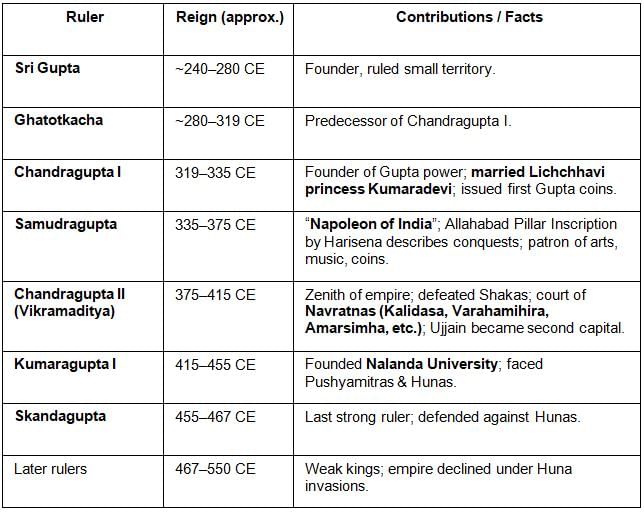SSC CGL Exam > SSC CGL Notes > General Awareness for SSC CGL > Cheat Sheet: The Gupta Empire
Cheat Sheet: The Gupta Empire | General Awareness for SSC CGL PDF Download
| Table of contents |

|
| Background |

|
| Rulers of Gupta Dynasty (Table) |

|
| Administration & Society |

|
| Culture & Achievements (Golden Age) |

|
| Decline |

|
Background
- Time Period: ~320 CE – ~550 CE
- Founder: Sri Gupta (small ruler in Magadha region).
- Golden Age of India: Peak under Chandragupta II (Vikramaditya).
- Capital: Pataliputra (later also Ujjain).
Rulers of Gupta Dynasty (Table)

Administration & Society
- Kingship: Hereditary, divine right.
- Council of Ministers assisted the king.
- Provinces called Bhuktis, headed by Uparika.
- Villages had strong local self-government.
- Revenue: Mainly land tax (1/4th of produce).
Culture & Achievements (Golden Age)
Literature:
- Kalidasa → Abhijnanashakuntalam, Meghaduta, Raghuvamsha.
- Amarsimha → Amarakosha.
Science & Mathematics:
- Aryabhata → Aryabhatiya (concept of zero, decimal, rotation of Earth).
- Varahamihira → Brihatsamhita.
Education: Nalanda University (famous for Buddhist studies).
Art & Architecture: Ajanta & Ellora caves, Dashavatara temple (Deogarh).
Coins: Gold coins (dinars) with high artistic quality.
Decline
- After Skandagupta → weak successors.
- Invasions of Hunas (Toramana & Mihirkula).
- Rise of regional kingdoms → Gupta Empire declined by ~550 CE.
The document Cheat Sheet: The Gupta Empire | General Awareness for SSC CGL is a part of the SSC CGL Course General Awareness for SSC CGL.
All you need of SSC CGL at this link: SSC CGL
|
448 videos|1497 docs|288 tests
|
FAQs on Cheat Sheet: The Gupta Empire - General Awareness for SSC CGL
| 1. What were the key features of the administration during the Gupta Empire? |  |
Ans. The administration of the Gupta Empire was characterized by a centralized governance system. The emperor held supreme power, supported by a council of ministers. Local governance was managed through a hierarchy of officials, including provincial governors and village headmen. The empire was divided into provinces called "maharashtras," each administered by a governor. Efficient tax collection and a well-organized military were also significant aspects of Gupta administration.
| 2. How did the Gupta Empire contribute to cultural advancements during its reign? |  |
Ans. The Gupta Empire is often referred to as the Golden Age of India due to its remarkable contributions to culture. This period saw advancements in literature, with notable works by poets like Kalidasa. In the field of science, scholars like Aryabhata made significant contributions to mathematics and astronomy, including the concept of zero and the calculation of the value of π. Art and architecture flourished, as evidenced by the construction of temples and sculptures, which showcased intricate designs and religious themes.
| 3. What were the main achievements of the Gupta Empire that signify its Golden Age? |  |
Ans. The Gupta Empire's Golden Age is marked by several key achievements, including advancements in mathematics, where the concept of zero and the decimal system were developed. In medicine, Sushruta's medical texts laid the foundation for surgery. The period also saw the flourishing of arts, with exquisite sculptures and paintings, particularly in places like Ajanta and Ellora. Additionally, the establishment of universities, such as Nalanda, promoted learning and attracted scholars from various regions.
| 4. What factors contributed to the decline of the Gupta Empire? |  |
Ans. The decline of the Gupta Empire can be attributed to several factors, including internal strife, weak leadership, and succession issues. Frequent invasions by the Huns disrupted the stability of the empire, leading to territorial losses. Economic difficulties due to over-reliance on agriculture and a declining trade network further weakened the empire. Additionally, the decentralization of power as local rulers gained more autonomy contributed to the fragmentation of Gupta authority.
| 5. Who were the notable rulers of the Gupta Dynasty and their contributions? |  |
Ans. Notable rulers of the Gupta Dynasty include Chandragupta I, who established the empire and expanded its territories. His son, Samudragupta, is often referred to as the "Napoleon of India" for his military conquests and expansionist policies. Chandragupta II, also known as Vikramaditya, is celebrated for promoting arts and culture, further enhancing the empire's reputation. Each ruler played a significant role in consolidating power and contributing to the empire's achievements during its Golden Age.
Related Searches



















